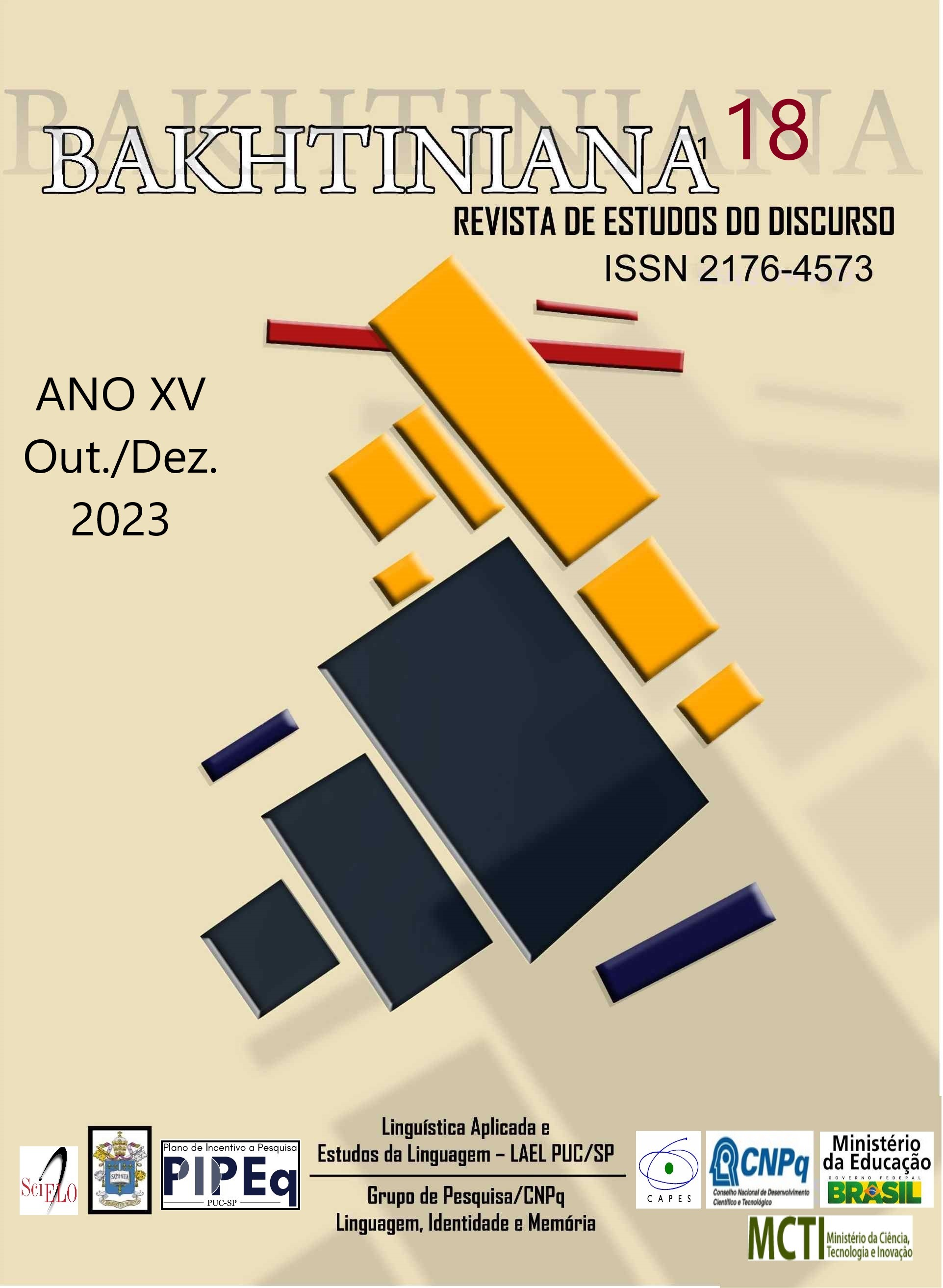Realismo grotesco e corpo grotesco em Bakhtin
Palabras clave:
Bakhtin, Grotesco, Realismo, Corpo, RabelaisResumen
Nesse artigo, discutiremos os conceitos bakhtinianos de realismo grotesco e corpo grotesco a partir de diferentes aspectos, a começar pelas abordagens sincrônicas feitas pelos linguistas e semióticos contemporâneos nossos, mas também pela abordagem que o próprio Bakhtin fez desses conceitos desde a pré-história deles, isto é, enquanto o pensador russo elaborava-os em sua tese de doutorado, no contexto da União Soviética na primeira metade do século XX. Depois disso, discutiremos o significado de ambos os conceitos no interior da obra A cultura popular na Idade Média e no Renascimento: O contexto de François Rabelais e, por fim, examinaremos algumas manifestações do grotesco em obras literárias e de artes plásticas do judaísmo antigo e do cristianismo antigo e medieval, as quais foram direta ou indiretamente citadas ou aludidas por Bakhtin.
Citas
AUERBACH, Erich. O mundo na boca de Pantagruel. In: AUERBACH, Erich. Mímesis: A representação da realidade na literatura ocidental. George Bernard Sperber e equipe da Perspectiva. São Paulo: Perspectiva, 2011, p. 229-248.
BAKHTIN, Mikhail. A cultura popular na Idade Média e no Renascimento: O contexto de François Rabelais. Tradução da versão francesa de Yara Frateschi Vieira. São Paulo: Hucitec, 2010.
BAKHTIN, Mikhail. Rabelais and His World. Transl. Helene Iswolky. Indiana University Press, 1984.
BAKHTIN, Mikhail. The Dialogic Imagination. Austin: University of Texas Press, 1981.
BERNARDI, Rosse Marye. Rabelais e a sensação carnavalesca do mundo. In: BRAIT, Beth (org.). Bakhtin, dialogismo e polifonia. São Paulo: Editora Contexto, 2009, p. 73-94.
BERNARDINI, Aurora. Os escritores russos na época do populismo. Outra Travessia. UFSC. Florianópolis, n. 7, p. 109-116, 2008. Disponível em: https://periodicos.ufsc.br/index.php/Outra/article/view/11982. Acesso em: 23 out. 2023.
BERREMONG, Richard. Rabelais and Bakhtin: Popular Culture in “Gargantua and Pantagruel”. Nebraska: University of Nebraska Press, 1986.
BRANDIST, Craig. Bakhtin, Cassirer and Symbolic Forms. Radical Philosophy, n. 85, set./out. 1997. Disponível em: https://www.radicalphilosophyarchive.com/issue-files/rp85_article2_bakhtincassirersymbolicforms_brandist.pdf. Acesso em: 23 out. 2023.
BRANDIST, Craig. Marxism and Russian Populism. In: BRANDIST, Craig; TIHANOV, Galin (eds.). Materializing Bakhtin: The Bakhtin Circle and Social Theory. London: MacMillan Press, 2000, pp. 70-93.
BRANDIST, Craig. Carnival Culture and Soviet Modernist Novel. London: MacMillan Press, 1996.
BRANDIST, Craig. Bakhtin’s Grand Narrative: The Significance of The Renaissance. Dialogism, n. 3, pp. 11-30, 1999.
BRANDIST, Craig. The Bakhtin Circle: Philosophy, Culture and Politics. London: Pluto Press, 2002.
BURKE, Peter. Cultura popular na Idade Moderna: Europa, 1500-1800. Trad. Denise Bottmann. São Paulo: Companhia das Letras, 2010.
CAÑIZAL, Eduardo Peñuela. Realismo grotesco. In: BRAIT, Beth (org.). Bakhtin: outros conceitos-chave. 4. ed. São Paulo: Editora Contexto, 2010.
CHAMBERLAIN, Lesley. Mãe Rússia: uma história filosófica da Rússia. Rio de Janeiro: Editora Record, 2022.
CLARK, Catarine; HOLQUIST, Michael. Mikhail Bakhtin. Trad. J. Guinsburg. São Paulo: Editora Pespectiva, 2004.
DISCINI, Norma. Carnavalização. In: BRAIT, Beth (org.). Bakhtin: outros conceitos-chave. São Paulo: Editora Contexto, 2008, p. 53-93.
EMERSON, Caryl. Os 100 primeiros anos de Mikhail Bakhtin. Trad. Pedro Jorgensen Jr. Rio de Janeiro: Difel, 2003.
ENOCH I. Translated by E. Isaac. In: CHARLESWORTH, James H. (ed.). The Old Testament Pseudepigrapha. Vol. One. Apocalyptic Literature and Testaments. Massachusetts: Hendrickson Publishers, 1983, pp. 5-100.
ENOCH II. Translated by F. I. Andersen. In: CHARLESWORTH, James H. [ed.]. The Old Testament Pseudepigrapha. Vol. One. Apocalyptic Literature and Testaments. Massachusetts: Hendrickson Publishers, 1983, pp. 101-222.
GRILLO, Sheila Vieira de Camargo. Do livro à tese de Bakhtin sobre Rabelais (1930-1952): Projeto, contexto, desfecho. Alfa, São Paulo, v. 66, e15167, 2022. https://doi.org/10.1590/1981-5794-e15167.
GUREVICH, Aaron. Bakhtin e sua teoria do carnaval. In: BREMMER, Jan; ROODENBURG, Herman (orgs.). Uma História Cultural do Humor. Trad. Cynthia Azevedo e Paulo Soares. Rio de Janeiro: Editora Record, 2000, p. 83-92.
GURIÊVITCH, Aaron. A síntese histórica e a Escola dos Anais. Trad. Paulo Bezerra. São Paulo: Editora Perspectiva, 2003.
KAYSER, Wolfgang. O grotesco: configuração na pintura e na literatura. São Paulo: Perspectiva, 2003.
KRISTEVA, Julia. Semiotike: Recherches pour une sémanalyse. Paris: Editions du Seuil, 2014.
OLIVER, Élide Valarini. Rabelais e Joyce: três leituras menipéias. Estudos Literários; 25. São Paulo: Ateliê Editorial, 2008.
PANOFSKY, Erwin. Arquitetura gótica e escolástica: sobre a analogia entre arte, filosofia e teologia na Idade Média. Trad. Wolf Hörnke. São Paulo: Martins Fontes, 1991.
PANOFSKY, Erwin. Significado nas artes visuais. São Paulo: Editora Perspectiva, 2017.
PEREIRA, F. H. Esteves (ed.). Visão de Túndalo (Códice 244). Revista Lusitana, v. III, 1895, p. 97‐120.
PROPP, Vladimir. Comicidade e riso. Trad. Aurora Fornoni Bernardini e Homero Freitas de Andrade. São Paulo: Editora Ática, 1992.
RABELAIS, François. Gargântua e Pantagruel. Trad. David Jardim Júnior. Belo Horizonte: Itatiaia, 2009.
RENFREW, Alastair. Mikhail Bakhtin. Abingdon: Routledge, 2015.
TIHANOV, Galin. A importância do grotesco. Bakhtiniana: Revista de Estudos do Discurso, v. 7, n. 2, p. 166–180, jul./dez. 2012. Disponível em: https://revistas.pucsp.br/index.php/bakhtiniana/article/view/11381. Acesso em: 23 out. 2023.
TIHANOV, Galin. The Master and the Slave: Lukacs, Bakhtin and the Ideas of Their Time. Oxford: Claredon Press, 2000.
TODOROV, Tzvetan. Mijaíl Bajtín: El principio dialógico. Trad. Mateo Cardona Vallejo. Bogotá: Publicaciones del Instituto Caro e Cuervo, 2012.
Descargas
Publicado
Cómo citar
Número
Sección
Licencia
Derechos de autor 2023 Bakhtiniana. Revista de Estudos do Discurso

Esta obra está bajo una licencia internacional Creative Commons Atribución 4.0.
Los autores le conceden a la revista todos los derechos autorales referentes a los trabajos publicados. Los conceptos emitidos en los artículos firmados son de absoluta y exclusiva responsabilidad de sus autores.








